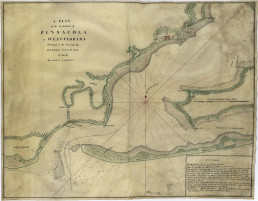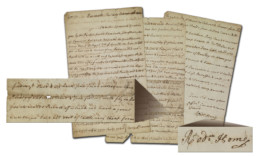By Ken Cameron and Paul Schullery
Sport fishing was popular in a variety of American locations even in the 1600s, but records of fly fishing are rare before the early 1800s.1 A letter recently acquired by the University of Virginia Library appears to set a new early date for fly fishing in the Americas, although by only two years. Its importance lies as much in the location as in the date; our earliest known American fly fisher enjoyed the sport in the Florida panhandle.2
The letter, dated Pensacola, Tuesday, October 28th, 1764, is from a man identified in the University of Virginia Library records as Rodney Home, written to a Mr. Blacket, presumably in England. Blacket’s name is assumed from a sentence late in the letter: “Respectful compliments to Mrs Blacket Miss Sally & your other Dear little child who I have not had the honour of knowing its Name yet.”3
Credit and congratulations for this discovery go to Mr. Lin Respess, antiquarian book dealer of Charlottesville, Virginia, who acquired the letter from another dealer and sold it to the University of Virginia Library in 2007. Respess listed the Home letter in his catalog under the heading “1764 Letter from Florida, with an Early, Perhaps the Earliest, Mention of Fly Fishing There.”4
The first name in the signature on the Home letter is unclear. It shows only the first three letters, “Rod,” in normal script, and the rest of the name is in superscript that, when enlarged, appears to read “in.” It is hoped that additional research will clarify Mr. Home’s identity and provide us with more information about him.

A map of Pensacola Harbor based on the surveys of George Gault, who was among those accompanying George Johnstone when he arrived in Florida in October 1764. Geography and Map Division, Library of Congress, digital ID g3932p ar165600.
For now we can say that Home appears to have been a member of the entourage of George Johnstone, the first governor of the then-new West Florida Colony.5 This British acquisition was one of the results of the Seven Years (“French and Indian”) War; Johnstone had, in fact, been appointed in 1763 but necessarily took his time getting to Pensacola. Home apparently arrived with the governor (“ten days ago yesterday”6) despite a bout of illness in Jamaica. Short as his time in Florida had been, however, Home had already sampled the local fishing: “We have plenty of salt [?] water trout & fine fishing with fly in the fresh water Rivers of which we have a great number . . .”7
We have no way of knowing what the flies or the fish were, except that they were certainly not salmonids. Home appears not to have been disappointed by that, however, having written that the fly fishing was “fine.”

Image credit: Rodney Home Letter, 1764, Accession #13918, Special Collections, University of Virginia Library, Charlottesville, Virginia.
The previous early certain date for North American fly fishing was Joseph Banks’s diary entry of 1766 in the northern maritime provinces of Canada.8 Banks described fishing for tidewater brook trout. The evidence of American fly-fishing activity following Banks’s report is slight but tantalizing. Newspapers and manuscripts from the 1770s described the sale of flies in stores in Boston and Philadelphia, as well as an apparent commercial fly tier in Philadelphia as early as 1773.9 But our next named fly fishers appear to be Londoner Robert Hunter Jr., whose diary described successfully fly fishing for bass on the Canadian banks of the St. Lawrence River in 1785,10 and British Colonel John Enys, who successfully fly fished for salmon in one of the rivers flowing into Lake Champlain at about the same time.11 Pennsylvania-born George Gibson, in a series of articles on fly fishing published in American sporting periodicals between 1829 and 1849, reminisced vaguely about having begun his fly-fishing career on the limestone streams of southeastern Pennsylvania in about 1790.12 Intriguing conjectures of other early New-World fly fishers are just that—conjectures—and await the discovery of more evidence.13
One thing that is noteworthy about all of these known fly fishers is that before Gibson, they were British visitors, not locals. The apparent geographical spread (Florida to the Maritimes), therefore, is somewhat illusory; it was the nationality of the visitors, not the location, that led them to fish with flies. We can assume that there were other visitors like them, including British and German military during the Revolution, but what we lack so far is a record of specific individuals who were either resident in the Americas or born there, who fished with the fly at the same time or even earlier than did these visiting anglers.
Ken Cameron is a former registrar, and Paul Schullery a former executive director, of the museum.
This article first appeared in the Summer 2011 (vol. 37, no. 3) issue of The American Fly Fisher.
Endnotes
- Paul Schullery, American Fly Fishing: A History (New York: The Lyons Press, 1987), 13–17.
- Rodney Home Letter, 1764, Accession #13918, Box W/5624. Special Collections/Marion duPont Scott Sporting Collection, University of Virginia Library, Charlottesville, Virginia.
- Ibid.
- Lin Respess, e-mail message to Paul Schullery, 16 February 2011.
- General background for the place and period provided by Robert V. Haynes, “Mississippi Under British Rule—British West Florida,” Mississippi History Now, An online publication of the Mississippi Historical Society, http://mshistory.k12.ms.us/, posted September 2000; accessed 25 March 2011.
- Home Letter.
- Ibid.
- David Ledlie, “A Colonial Fly Fisher,” The American Fly Fisher (Summer 1980, vol. 7, no. 3), 14–15.
- Schullery, American Fly Fishing, 23–24.
- David Ledlie, “More on Sir William Johnson,” The American Fly Fisher (Spring 1984, vol. 11, no. 2), 2–6.
- Austin Hogan, “Bob Fly, Dropper—Tail Fly, Stretcher,” The American Fly Fisher (Fall 1976, vol. 3, no. 4), 11.
- Paul Schullery, Royal Coachman (New York: Simon & Schuster, 1991), 65–66.
- Schullery, American Fly Fishing, 18–20, reviewed the cases of British angling writers Richard Franck and Richard Brookes, both of whom are thought to have visited America, Franck in the 1600s and Brookes some time before 1763. Ledlie, “More on Sir William Johnson,” reviewed the as-yet-unsubstantiated case made for Sir William Johnson’s having fly fished the Mohawk Valley of New York as early as 1761.

